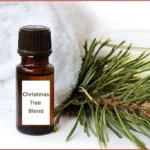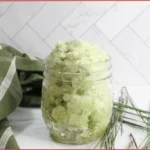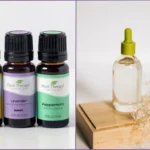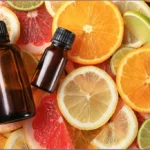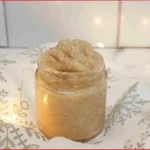This melt-and-pour loofah soap recipe is an easy and rewarding DIY project that delivers a spa-like exfoliating experience at home.
The best part about this melt and pour soap recipe?
You can customize it to any season by infusing it with seasonal exfoliants, aromas, and colors, from the warm spices of winter to the cool, refreshing notes of summer.

✨ Get 12 Free Holiday Diffuser Blends — Printable PDF
Instantly make your home smell like Christmas with these festive, ready-to-use recipes.
I used cinnamon powder in this loofah soap recipe as it’s one of the most popular Christmas aromas.
I plan to add this cinnamon-scented soap to my Christmas aromatherapy gift basket along with other DIY bath and body care products scented with essential oils.
As you scroll further down, you’ll find plenty of ideas on customizing the basic recipe to create beautifully unique, skin-friendly loofah soaps for different seasons.
Table of Contents
Affiliate Disclosure: Some links on this site are affiliate links. I may earn a small commission if you purchase through them, at no extra cost to you. See the full affiliate disclosure.
Cinnamon Loofah Soap Recipe: Ingredients

Here’s what you’ll need:
1 lb Suspension Melt and Pour Soap Base: This is key to even exfoliant distribution.
Loofah Slices: Pre-cut loofah pieces or a natural loofah sponge that you can slice to fit your mold.
3 tablespoons Cinnamon Powder: For exfoliation and a festive, warm scent.
Essential Oils (Optional): Add oils like vanilla, clove, or orange for an enhanced seasonal aroma.
Soap Molds: You can use any mold. You’ll get 4 soaps with this mold.
For best results, choose high-quality, natural ingredients, especially if giving the soap as a gift or using it on sensitive skin.
How To Make Loofah Soap: Step By Step Instructions
Here are the step-by-step instructions how to make this cinnamon loofah soap:
Prepare the Loofah
I used pre-cut roundels that fit perfectly in the soap mold I was using. You can cut the loofah rounds to fit into smaller molds or cut them into different shapes for added variation.
Soak the loofah rounds briefly in warm water to soften,making them easier to work with. This step is not mandatory.
Melt the Soap Base

Cut the soap base into small pieces and place them in a microwave-safe bowl.
I used goat’s milk suspension melt and pour soap base but you can use one make of shea butter or glycerine too.
Melt in 15- to 30-second intervals on low heat, stirring each time until fully melted. Avoid overheating, as this may affect the soap’s quality.
Or heat gently in a double boiler on the stovetop.
Add Cinnamon Powder

Add about 2 – 3 tablespoons of cinnamon powder to the melted soap base and stir well to ensure even distribution. Start with a smaller quantity for sensitive skin.
Wait for the soap to cool a bit before adding essential oil if you want a richer scent. This step is optional.
When choosing essential oils, it is important to consider the overall scent profile you want to achieve. Experiment with different combinations of oils to find the perfect blend for your soap.
Vanilla is the best essential oil to use in this cinnamon loofah soap recipe. Its sweet, comforting aroma soften the spiciness of cinnamon. Vanilla also has moisturizing properties that are beneficial for the skin.
Sweet Orange essential oil is another great option. Its bright, citrusy scent balances out the warmth of cinnamon. Sweet orange also has uplifting and energizing properties.
Pour into Molds

Place one loofah slice in each mold cavity, then pour the soap mixture over it.
If the loofah floats up, gently press it own with a spatula so submerge it into the soap.
Set and Remove

Let the soap cool and harden.
It can take several hours for the soap to harden completely. I left the soap to cool overnight.
You can place the soap molds in the fridge to speed up the process.
Once firm, gently pop each soap out of its mold.
Suspension Melt and Pour Soap Base Is Perfect for Textured & Exfoliating Soaps
Using a suspension melt and pour soap base is key to achieving a well-mixed and visually appealing soap when incorporating solid additives like cinnamon powder, coffee grounds, or crushed herbs and petals.
A suspension base keeps the particles suspended throughout the soap, creating a textured and visually appealing bar. It also gives your soap a consistent texture, allowing each bar to have the same level of exfoliation throughout.
This is unlike standard melt and pour soap bases in which the particles tend to clump or settle at the bottom.
Note: You need to use a suspension soap base only when adding solid additives. A regular soap base works just fine for other melt and pour soap recipes.
Benefits and Precautions of Cinnamon in Soap

Cinnamon is an excellent addition to homemade melt and pour soap recipes, particularly for fall and winter. It adds a warm, inviting aroma to soap, making it perfect for the cooler seasons.
Moreoever, cinnamon contains compounds that give skin a fresh and healthy glow.
However, there are some downsides that you should be aware of. Because cinnamon can be potent, you must use it in moderation. Too much may irritate sensitive skin.
If you experience redness or irritation, consider a smaller amount or choose a different exfoliant.
Alternative Exfoliants for Seasonal Loofah Soaps
For variety, consider swapping out cinnamon with other exfoliants that suit different seasons:
Spring and Summer Exfoliants
Dried & Crushed Petals & Herbs: Dried and crushed petals such as rose and lavender or herbs such as rosemary offer gentle exfoliation and a refreshing scent that’s perfect for spring and summer.
Citrus Peels: Powdered lemon or orange zest add a light, invigorating fragrance that pairs well with warm-weather vibes. See how easy it is to make orange peel powder. Use the same instructions for making lemon peel powder.
Autumn and Winter Exfoliants
Coffee Grounds: Great for deep exfoliation and a rich, cozy scent.
Oatmeal: Soothing for sensitive skin and adds a lovely, natural texture.
Sea Salt or Pink Himalayan Salt: A coarser texture that feels indulgent and luxurious.
How to Use Loofah Soap

Loofah soap can be a powerful exfoliant, so it’s best used a few times a week rather than daily, especially if you have sensitive skin.
To use:
Wet the soap and your skin to reduce friction and avoid potential irritation.
Rub the loofah soap in circular motions, focusing on areas needing extra exfoliation, like elbows, knees, and feet. Be especially gentle when using on delicate facial skin.
Rinse thoroughly to wash away dead skin cells and any lingering exfoliant.
Follow up with a moisturizer to keep skin hydrated and soft.
Caring for Loofah Soap
Proper care ensures your loofah soap remains fresh and functional. Here’s how:
Dry Between Uses: Place the soap on a well-draining soap dish or holder to prevent it from becoming soggy.
Store in a Cool, Dry Place: When not in use, keep your soap in a cool area to maintain its firmness and scent.
Keep Away from Direct Water Streams: Exposure to water can lead to quicker breakdown, so avoid keeping it directly in the shower’s water stream.
Packaging Loofah Soap for Gifts

Loofah soap makes a wonderful, practical gift. Here are a few packaging ideas:
Wrap in Eco-Friendly Materials: Consider using recyclable paper or fabric wraps, which are sustainable and stylish.
Decorative Tins or Baskets: Arrange several bars in a tin or basket with themed decor, like autumn leaves for cinnamon soap or dried flowers for herbal varieties.
Personalized Labels and Tags: Add a handwritten or printed label with the scent, key ingredients, and suggested uses for a personal touch.
Seasonal Ribbons: Finish the look with a seasonal ribbon or bow, matching the theme for added charm.
Creating loofah soap at home allows you to enjoy a unique, personalized exfoliating experience and seasonal aromas that fit your mood. Experimenting with natural exfoliants and essential oils can lead to endless variations that cater to different skin types, scents, and occasions.
With this recipe, you’re ready to make a thoughtful, handmade addition to your skincare routine or share a delightful gift with loved ones.
Loving making your own bath and body care products? You’ll love these recipes:
Melt & Pour Shea Butter Soap Recipe with Floral Essential Oils
How to Make Sea Moss Soap Without Lye + Benefits & Customization
Hydrating Hibiscus Body Scrub Recipe For Soft, Radiant Skin
Luxurious Whipped Body Butter Recipe With Essential Oils
